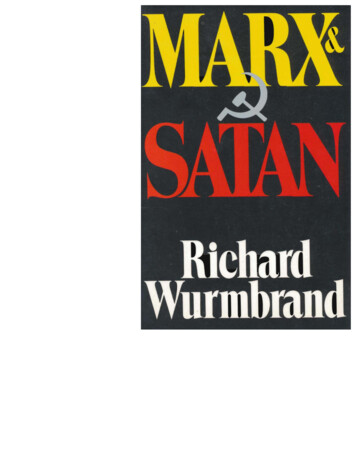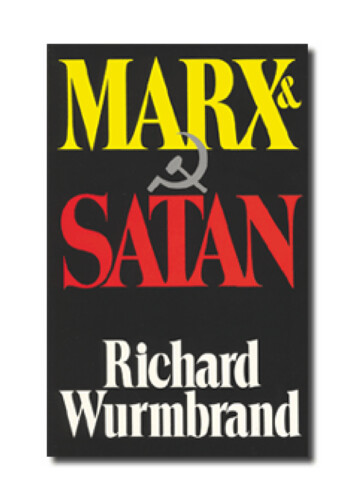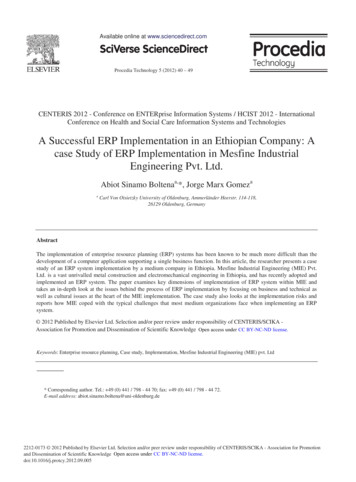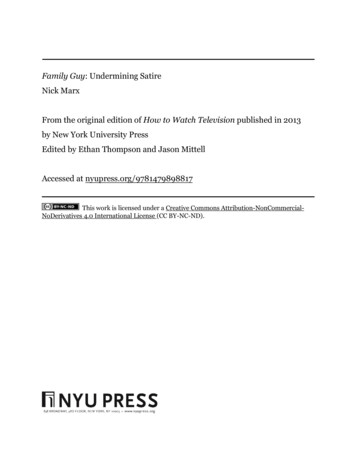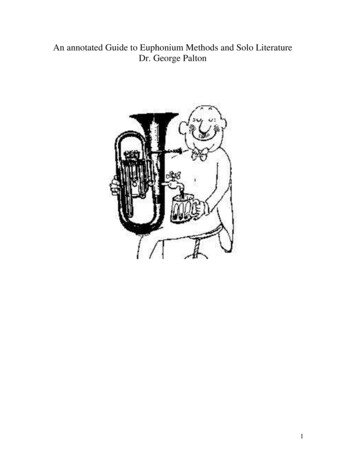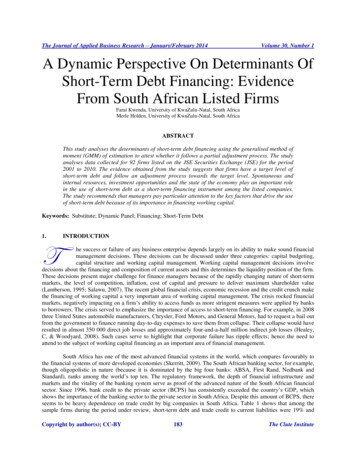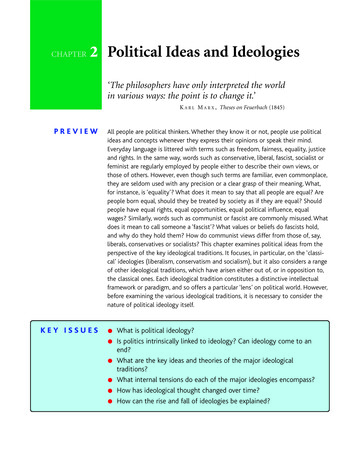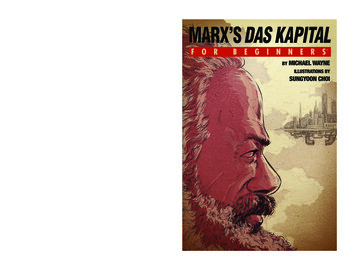
Transcription
Cover:Layout 13/14/122:09 PMPage 1F O RB E G I N N E R SMarx’s Das Kapital For Beginners offers an accessible path through Marx’sarguments and his key questions: What is a commodity? Where does wealthcome from? What is ‘value’? What happens to work under capitalism? Whyis crisis part of capitalism’s DNA? And what happens to our consciousness,our very perceptions of reality and our ways of thinking and feeling undercapitalism? Understanding and learning from Marx’s work has taken on afresh urgency as questions about the sustainability of the capitalist systemin today’s global economy intensify.Michael Wayne is a Professor in Screen Media at Brunel University in London. He haswritten widely on Marxist cultural theory, film, television and the media.KNOW MORE. READ LESS.ADOCUMENTARYCOMIC BOOK www.forbeginnersbooks.comHISTORY / ECONOMICSTMUS 16.99 / 18.99 CANF O R B E G I N N E R S Marx’s Das Kapital cannot be put into a box marked “economics.” It is awork of politics, history, economics, philosophy and even in places,literature (yes Marx’s style is that rich and evocative). Marx’s Das KapitalFor Beginners is an introduction to the Marxist critique of capitalistproduction and its consequences for a whole range of social activities suchas politics, media, education and religion. Das Kapital is not a critique ofa particular capitalist system in a particular country at a particular time.Rather, Marx’s aim was to identify the essential features that definecapitalism, in whatever country it develops and in whatever historicalperiod. For this reason, Das Kapital is necessarily a fairly general, abstractanalysis. As a result, it can be fairly difficult to read and comprehend. Atthe same time, understanding Das Kapital is crucial for mastering Marx’sinsights to capitalism. MARX’S DAS KAPITALMARX’S DAS KAPITALMARX’S DAS KAPITALF O RB E G I N N E R S BY MICHAEL WAYNEILLUSTRATIONS BYSUNGYOON CHOI
Book2:Layout 13/19/121:36 PMPage IMARX’S DAS KAPITALF O RB E G I N N E R S
Book2:Layout 13/19/121:36 PMPage II
Book2:Layout 13/19/121:36 PMPage IIIMARX’S DAS KAPITALF O RB E G I N N E R SBY MICHAEL WAYNEILLUSTRATIONS BYSUNGYOON CHOIFOR BEGINNERS an imprint of Steerforth PressHanover, New Hampshire
Book2:Layout 13/19/121:36 PMPage IVFor Beginners LLC155 Main Street, Suite 211Danbury, CT 06810 USAwww.forbeginnersbooks.comText 2012 Michael WayneIllustrations 2012 Sungyoon ChoiThis book is sold subject to the condition that it shall not, byway of trade or otherwise, be lent, re-sold, hired out, or otherwise circulated without the publisher’s prior consent in any formof binding or cover other than that in which it is published andwithout a similar condition being imposed on the subsequentpurchaser.All rights reserved. No part of this publication may be reproduced,stored in a retrieval system, or transmitted in any form or by anymeans, electronic, mechanical, photocopying, recording, or otherwise, without prior permission of the publisher.A For Beginners Documentary Comic BookCopyright 2012Cataloging-in-Publication information is available from the Library ofCongress.ISBN # 978-1-934389-59-1 TradeManufactured in the United States of AmericaFor Beginners and Beginners Documentary Comic Books arepublished by For Beginners LLC.First Edition10 9 8 7 6 5 4 3 2 1
Book2:Layout 13/19/121:36 PMPage Vcontentsintroduction1chapter one The Commodity3chapter two The Exchange of Commodities15chapter three Circulation and the Buying of Labor-Power25chapter four Value43chapter five Work Under Capitalism59chapter six Reproduction and Crises78chapter seven Commodity Fetishism and Ideology109chapter eight After Capitalism?130
Book2:Layout 13/19/121:36 PMPage VI
Book2:Layout 13/19/12Karl Marx1:36 PMPage 1introductionKarl Marx’s Das Kapital, Volume I, was first published in 1867. Itbrought together in an original way more than twenty years of thinking by Marx about capitalism.Das Kapital is a critique of capitalism. It is not this or that particular example of capitalism that is his target. Instead Marx wanted to identify the essential features that make capitalism capitalism,in whatever country it develops in and in whatever historical period. For this reason, Das Kapital is necessarily a fairly general, abstract analysis – one of the reasons why it can be a difficult read.Another reason is that its penetrating critique of capitalism is attacking the very system that you, dear reader, and I, author of thesewords, have grown up in, become socialized within. So it is sometimes a quite counterintuitive read in that it does not accept the manycommonsense assumptions we have and which the institutions surrounding us usually reproduce.Capitalism is a social and economic system that has been developing and maturing for approximately 400 years. Since the publicationof Das Kapital, capitalism has tried to prove Marx’s critique wrongor irrelevant, but it continues to fashion tools for each new generation wanting to understand the world. Today, capitalism’s presencearound the globe is more or less complete, its dominance almost undisputed. So why do we need to read Marx’s book anymore?Because most people have at least an inkling that all is not right withthe world. And many people have more than an inkling that there arevery large problems confronting the human race. Marx’s Das Kapitalprovides the most systematic account for why that might be the case.1
Book2:Layout 13/19/121:36 PMPage 2Das Kapital cannot be or should not be put in a box marked “economics.” It is a work of politics, history, economics, sociology, philosophy and even at times literature (yes, Marx’s style can be that richand evocative). It even contains early examples of Marxist literary criticism. Marx often cites great authors such as Shakespeare, Goetheand Balzac to illustrate issues to do with the nature of money.For example, when he is considering how the bourgeoisie (andthe capitalist system more broadly) is torn between the passion toaccumulate money and the desire to enjoy the fruits of that wealth,he cites the protagonist of Goethe’s tragic play Faust as the very image of bourgeois man:Two souls, alas, do dwell within his breast;The one is ever parting from the other.As we shall see, two souls forever parting from each other (thedivided human being split by conflicting imperatives) is a typical motif in Marx’s account of capitalism.Marx’s approach here is revealing of hismethod overall. He tends to read politics,economics, religion, philosophy and in thisexample literature for their HIDDENsocial content.The main object of his inquiry in DasKapital is why and how economic categories such as money, profit, capitaland so forth actively repress the socialcontent which determines them. However, because these categories refer tothings that form the very tissue of oureveryday life, Das Kapital is a capacious project, giving us insights that go far beyondthe usual parameters of “economics.”Das Kapital begins a bit like a detectivestory, reconstructing what is really happening from everyday clues that appear so innocent of having any story to tell. When Inspector Marx arrives on thescene it is not even clear a crime has been committed. But it has.2
Book2:Layout 13/19/121:36 PMPage 3chapter one:the commodityMarx began his critique of capitalism with something very ordinaryand everyday. The commodity. The first words of Das Kapital are:The wealth of those societies in which the capitalistmode of production prevails presents itself as an immense accumulation of commodities, its unit being a single commodity. Our investigation must therefore beginwith the analysis of a commodity.— Marx, Das KapitalEveryone knows that a commodity is something that is boughtand sold, or traded for something else thought to be of equal worth.And it is plain that commodities are bought and sold because theyare useful for people.So a commodity has two sides to it. It has a use value and an exchange value. An exchange value expresses itself as the price at whichthe commodity exchanges.This then is our opening definition of a commodity: It is somethingthat is bought and sold because it is useful for people. Expressed likethis, there does not seem to be a problem. The use-value side of thecommodity and the exchange-value side seem to fit snugly together.A commodity appears, at first sight, a very trivial thing,and easily understood. Its analysis shows that it is, inreality, a very queer thing, abounding in metaphysicalsubtleties and theological niceties.— Marx, Das Kapital3
Book2:Layout 13/19/121:36 PMPage 4If at first sight the commodity appears a trivial, easily understoodthing, Marx will show that within capitalism, things are not as theyappear.Marx’s analysis reveals how, in fact, use value and exchange value are at war with each other within modern capitalism.Let us first consider the use-value side of things. Think about a random sample of products: a teabag, a hammer and a pair of binoculars.The first thing you notice about them as use values is how different their uses are. Indeed they are quite unique to each product.Try using a teabag to bang in some nails, or a hammer to magnify a distant object and you are unlikely to have much success.The utility of a thing makes it a use value. But this utilityis not a thing of air. Being limited by the physicalproperties of the commodity, it has no existence apartfrom that commodity.— Marx, Das KapitalAs well as being distinct from each other, the unique uses theseproducts have depends very much on their physical structure.Imagine making a cup of tea with a teabag that did not have anyperforations.Or using binoculars that did not have any lenses inside them.So the usefulness of these products relates to their precise physical structure and combination of elements. Again this all points tothe unique and specific qualities they have for being useful.Where do the materials for products come from? Obviously theystart life as natural materials in some form or another. Tea comesfrom plants, their bags a blend of wood and vegetable-based fibers.A hammer made from steel comes from iron and carbon combinations. Glass necessary to make lenses also derives from such natural materials as sand and lime.Of course nature does not spontaneously transform itself into thesehandy products that make our lives better, more comfortable andmore developed. This is a transformation – almost magical in someways – that is produced by HUMAN LABOR.Labor is, in the first place, a process in which both manand nature participate, and in which man of his own4
Book2:Layout 13/19/121:36 PMPage 5accord starts, regulates, and controls the materialreactions between himself and nature. He opposeshimself to nature as one of her own forces, setting inmotion arms and legs, head and hands, the natural forcesof his body, in order to appropriate nature’s productionin a form adapted to his own wants. By thus acting onthe external world and changing it, he at the same timechanges his own nature. He develops his slumberingpowers and compels them to act in obedience to his sway.— Marx, Das KapitalSo use value has its origins in nature and human labor. And thisis true throughout human history – not just the recent history ofcapitalist production. Human beings have always produced use values from natural raw materials. And this process of production hasin turn developed us as creative, intelligent human beings.The labor process of human beings is quite different from the instinctual activity that governs animals.A spider conducts operations that resemble those of aweaver, and a bee puts to shame many an architect in theconstruction of her cells. But what distinguishes theworst architect from the best of bees is this, that thearchitect raises his structure in imagination before heerects it in reality. At the end of every labor process, weget a result that already existed in the imagination of thelaborer at its commencement. He not only effects achange of form in the material on which he works, buthe also realizes a purpose of his own that gives the law tohis modus operandi, and to which he must subordinatehis will.— Marx, Das KapitalBecause human labor is not directed by instinctual drives but bycreativity and imagination, human beings can be inventive. They canadapt to their environment and adapt their environment. They candiscover things about themselves and the natural world around them.All this opens up the possibility of making a human history distinctfrom the history of nature.5
Book2:Layout 13/19/121:36 PMFrederickEngelsPage 6The development of the humanhand as a tool-making organ was decisivein the development of a human history.As Marx’s lifelong friend and collaborator Frederick Engels wrote:The first operations for which ourancestors gradually learned toadapt their hands during the manythousands of years of transitionfrom ape to man could have beenonly very simple ones. The lowestsavages are nevertheless far superiorto these transitional beings. Before the first flint could befashioned into a knife by human hands, a period of timeprobably elapsed in comparison with which the historicalperiod known to us appears insignificant. But thedecisive step had been taken; the hand had become freeand could henceforth attain ever greater dexterity;the greater flexibility thus acquired was inheritedand increased from generation to generation.— Frederick Engels,The Part Played By Labor In TheTransition From Ape To Man6
Book2:Layout 13/19/121:36 PMPage 7So labor is the very basis of what and who we are as human beings. The unique use values that labor produces derive in turn fromthe specific qualities which particular kinds of labor bring to the rawmaterials they work on.If you want to make paper then it simply will not do to treat woodas if it were iron ore and put it in a hot furnace. Labor must workwith the particular qualities which different natural materials have.It will be important to remember the hymn to human creativityembodied in labor that Marx writes about here when we get to consider what happens to human labor under capitalism.Now, human labor produces two types of products. One type functions as tools or raw materials that will be used in further acts of labor. The other type produces final products that can be consumedor used by individuals to reproduce themselves – whether that is aroof over their heads or a bite to eat.Tools and raw materials that have already been worked upon byhuman labor remain only latent or potential use values. They requirefurther labor to make those use values a reality.Living labor must seize upon these things and rousethem from their death-sleep, change them from merepossible use values into real and effective ones. Bathed inthe fire of labor, appropriated as part and parcel of labor’sorganism, and, as it were, made alive for the performanceof their functions in the process, they are in truth consumed, but consumed with a purpose, as elementaryconstituents of new use values, of new products, everready as means of subsistence for individual consumption, or as means of production for some new laborprocess.— Marx, Das KapitalMarx’s argument that living labor is required to realize the potential inherent in tools (including advanced machinery) or raw materials will be very important later on for his analysis of capitalism.Finally we should note that although labor is absolutely centralto what Marx called our “species being,” labor is in turn dependent on nature. This relationship, Marx says in Das Kapital, is the,“everlasting nature-imposed condition of human existence, and there7
Book2:Layout 13/19/121:36 PMPage 8fore is independent of every social phase of that existence, or rather,is common to every such phase.”Just as it is worth thinking about what happens to human laborwhen capitalism comes on the historical scene, so too it is worththinking about what happens to nature and our relationship to nature under capitalism.For now, though, the one thing you need to take from what wehave said so far is that use values and the process of producing themare characterized by unique and specific qualities.We have been considering the use-value side of products. As wehave seen, human beings have always produced use values in orderto survive and in order to develop. That production is likely to havebeen under difficult and unjust circumstances (for example, serfdomor slavery) but that is not the issue right now.Use values constitute the substance of all wealth,whatever may be the social form of that wealth.— Marx, Das KapitalHowever, in the last few hundred years, the production of use values has been embodied largely in commodities. This is a new social form of wealth that we call capitalism, and it means that use values are now combined with exchange values.In the form of society we are about to consider, [use values] are, in addition, the material depositories of exchange value.— Marx, Das KapitalSo what is exchange value?It must be the value at which commodities exchange for each other. This exchange value finds its expression in prices. And what areprices?Prices are wooing glances cast at money by commodities.— Marx, Das KapitalIn money, commodities find an easily divisible and portable meansof exchange. But money also measures the value of commodities.So the exchange value of a commodity finds a mirror of its value in money.Where once in precapitalist times an ordinary commodity such8
Book2:Layout 13/19/121:36 PMPage 9as a chicken might havebeen traded for anotherordinary commoditysuch as salt, today, under capitalism, one ordinary commodity isexchanged for money.Commoditiesfind their ownvalue already represented withoutany initiative on theirpart, in another commodity existing in companywith them.— Marx, Das KapitalMoney is the universal mirror or equivalent that keeps companywith all other ordinary commodities. It is in fact no more than a commodity itself, because it is a representation of the exchange valueof the ordinary commodity.Money functions as a means of circulation only becausein it the values of commodities have independent reality.— Marx, Das KapitalWe can find out something important about the nature of exchangevalue by taking a closer look at money – which is both the meansof exchange and the measure of value.Imagine three piles of money, each bigger than the other. The firstthing that we notice about these piles of money is that there is verylittle difference between them. The only difference in fact is a quantitative one.Now this is in contrast to our three ordinary commodities we discussed earlier: the teabag, the hammer and the binoculars.We saw that each of those had very different qualities. Of coursethese qualities come in certain quantities. The quantitative dimension is a natural part of what they are, but it is the qualitative dimension that is most crucial to their differential usefulness. But money is pretty much just money. There is not a lot you can do with it.9
Book2:Layout 13/19/121:36 PMPage 10You cannot wear money, eat it, smoke it or use it to put nails intowoodwork. It has a very thin qualitative dimension. The most important thing about money for most people is its quantitative dimension: how much you have!You can of course spend money, which is what we generally dowith it. But money itself does not really have much of an intrinsicuse value in the way a teabag does or a painting by Picasso. As GeorgSimmel, a Marx-influenced German sociologist wrote at the turnof the twentieth century:Money, with all its colorlessnessand indifference, becomes thecommon denominator of all values; irreparably it hollows out thecore of things, their individuality,their specific value, and their incomparability.— Georg Simmel,The Metropolis andMental LifeGeorgSimmelSo in this sense money is not the same as an ordinary commodity. It is pure exchange value; it is the expression of the commodity only in terms of its monetary worth. To put it anotherway, it is the expression of only the exchange-value side of thecommodity.As use values, commodities are, above all, of different qualities, but as exchange values they are merely different quantities, and consequently do not contain an atom of use value.— Marx, Das KapitalWhat would it mean to look at our ordinary commodities as ifthey did not contain an “atom of use value”? Well, we would thenonly be measuring their value and the different amounts of each commodity that would make them equivalent.So around 100 teabags would be equivalent to one hammer andaround 1,000 teabags might be equivalent to a particular pair ofbinoculars, while maybe 7 hammers would equate to the same pairof binoculars.10
Book2:Layout 13/19/121:36 PMPage 11By making these commodities equivalent, we are no longer concerned with what differentiates them – i.e., their use values. In termsof their qualities they are all the same – simply expressions of value that are quantitatively comparable.Instead of taking 1,000 teabags to a shop selling binoculars, wetake money, but whether we take money or teabags, we would basically be implying the same thing: that 20 is equal to 1,000 teabagsor one pair of binoculars.The exchange of commodities is evidently an act characterized by atotal abstraction from use value.— Marx, Das KapitalIn making 1,000 teabags equivalent to 7 hammers and one pair ofbinoculars we are discarding theirdifferences and saying that they allshare something in common (the actof abstraction Marx writes about).What they share is the same monetaryworth. But what ultimately is value? Whatis being measured by money and what isbeing expressed in exchange value?11
Book2:Layout 13/19/121:36 PMPage 12Marx’s answer must initially strike us asstrange. It is the human labor power embodied in the commodities which givesthem their value.This is strange because we have alreadyseen that human labor isa producer of use valuesand it shares with usevalues their unique andspecific qualities. So howcan human labor power also becrystallized into a commodity as exchange value, as something that is“a mere congelation of homogenous human labor,” as Marx calls it?Something must happen to human labor when it starts producingcommodities under capitalism to enable wildly different commoditiesto be measured as equivalents.Along with the useful qualities of the products themselves, we put out of sight both the useful character ofthe various kinds of labor embodied in them and theconcrete forms of that labor. There is nothing left butwhat is common to them all; all are reduced to one andthe same sort of labor, human labor in the abstract.— Marx, Das KapitalSo while human labor produces use values on the one hand, onthe other, human labor undergoes some sort of “abstraction” andit is this abstract human labor that produces value in commodities.We have now learned that commodities are made up of two parts:use value and exchange value. We have begun to see that their combination in a commodity might not be as harmonious as we first supposed. Why? Because exchange value is entirely indifferent to use12
Book2:Layout 13/19/121:36 PMPage 13value. Use value and exchange value then arestrange bedfellows. They are joined together inthe commodity but one is characterized by theprinciple of quality (use value) and the otherby the principle of quantity (exchange value).Could commodities themselves speak,they would say: Our use value may be athing that interests men. It is no part ofus as objects. What, however, does belongto us as objects, is our value. Our natural intercourse as commodities proves it. In the eyesof each other we are nothing but exchange values.— Marx, Das KapitalWe can begin to see that the two sides of the commodity mightnot necessarily get along. We have the basis here of a contradiction.A contradiction arises when two principles that negate one another are embodied within a phenomenon, an object or a system.Further, we have seen that the twofold character of the commodityis related somehow to the twofold character of labor when it startsproducing commodities. On the one hand there is concrete labor,what Marx in Das Kapital calls “a special sort of productive activity, the nature of which is determined by its aim, mode of operation, subject, means, and result.”On the other hand there is abstract labor – which is not a separate activity but is woven into concrete labor. But abstract labor seemsto be the polar opposite of concrete labor. It has no specificity orparticularity about it. Abstract labor is homogeneous and equivalent, without differentiation, merely an expenditure of physiological energy.(We don’t know yet why labor becomes abstract – although thereare clues in what has been said so far – or how this abstract laborrelates to concrete labor, but we will find this all out later.)This has been the basis of how commodities exchange in modern societies. The upside of being able to equate wildly differentthings has been an enormous expansion of use values available tohuge numbers of people (money permitting). Marx was the first toapplaud the successes of capitalism.13
Book2:Layout 13/19/121:36 PMPage 14But we can already see that the internal contradictions betweenuse value and exchange value, and between concrete labor and abstract labor, are a problem. Marx was convinced that these contradictions, as they developed and deepened, eroded the historic justification for capitalism’s continued existence.At this point you might be wondering if you have picked up thewrong book. Perhaps you expected something about exploited workers and greedy capitalists? Well, we will get to them soon, but in order to understand what is at stake in that struggle, what social forcesthese types really represent, we need to proceed broadly, as Marx did.The method of analysis which I have employed, andwhich had not previously been applied to economic subjects, makes the reading of the first chapters rather arduous. There is no royal road to science, and only thosewho do not dread the fatiguing climb of its steep pathshave a chance of gaining its luminous summits.— Marx, Preface to theFrench edition of Das KapitalThe method of analysis Marx employed is called immanent critique. It starts with a simple category (e.g., the commodity) and gradually “unfolds” into more elaborate and complex webs of categories.It is motivated to do so because this “internal” criticism finds contradictions within and between the categories and discovers aspectsof reality that the categories cannot explain. This then motivates thecritic to develop new categories or refine old ones so they have greaterexplanatory power.This is an unusual approach, probably unfamiliarto many readers used to arguments being builtaround historical narratives and empirical information. Marx’s approach was influenced by theGerman philosophical tradition, especially the greatphilosopher Hegel. It is a powerful way into thesubject because his critique does not depend onMarx arbitrarily applying his own economic, political and moral yardsticks to capitalism. Instead,by the time Marx has finished, he has explodedHegelhis subject – capitalism – from within.14
Book2:Layout 15/4/1210:23 AMPage 15chapter two:the exchange of commoditiesNow we must enter a magical domain – the land of the market inadvanced capitalism. This is the domain where bourgeois economicsand politics are at their happiest because the way things appear herein the domain of exchange presents capitalism in the best possiblelight. This is the domain that provides the fertile soil in which manyof the ideals and values of capitalist society grow.It is plain that commodities cannot go to market andmake exchanges of their own account. We must, therefore, have recourse to their guardians, who are alsotheir owners. Commodities are things, and thereforewithout power of resistance against man. In orderthat these objects may enter into relation with eachother as commodities, their guardians must placethemselves in relation to one another, as persons whose15
Book2:Layout 13/19/121:36 PMPage 16will resides in those objects, and must behave in such away that each does not appropriate the commodity ofthe other, and part with his own, except by means of anact done by mutual consent. They must therefore, mutually recognize in each other the rights of private proprietors. This juridical relation, which thus expressesitself in a contract, whether such contract be part of adeveloped legal system or not, is a relation betweentwo wills, and is but the reflex of the real economic relation between the two.— Marx, Das KapitalMarx is being a little ironic here, because we will later find outthat commodities do in fact have “power of resistance” against theirsupposed owners. But our identity as consumers is fostered continually by capitalism within the sphere of exchange. Our sense thatbeing a consumer empowers us is rooted in the daily reality of entering the market. This is a realm apparently of freedom, a realmwhere commodity owners meet and exchange on the basis of consent. It is a realm of law and a place where we express our individual will. In other words, exchange is not just about economics, itis about how we behave, how we feel, what assumptions we makeand what society as a whole validates as “normal.”To look more closely at what goes on in the sphere of exchangewe must have some dramatis personae: a Buyer and Seller.Our Buyer sallies forth into the market in search of a coat. Winter is approaching and our Buyer wants to be prepared.Our Buyer has in her pocket a commodity which she can exchange16
Book2:Layout 13/19/121:36 PMPage 17for the coat she desires. That commodity is money, which Marx tellsus is merely a commodity itself – the commodity in money form.It is not money that renders commodities commensurable. Just the contrary. It is because all commodities, asvalues, are realize
For Beginners is an introduction to the Marxist critique of capitalist production and its consequences for a whole r ange of social activities such as politics, media, education and religion. Das Kapital is not a critique of a particular capitalist system in a particular country at a particular time.
